Solving Organizational Issues through Employee Development
VerifiedAdded on 2021/04/17
|15
|3568
|26
AI Summary
The assignment discusses the organizational issues faced by FoodStuffs, including a lack of proper training and developmental programs, declining job satisfaction, and a gap in organizational communication. The management took initiatives to address these issues by providing introductory training, monthly performance evaluations, uniform frequency training programs, creating a grievance cell, and improving the reward and recognition system. These efforts led to increased productivity and profitability within the organization.
Contribute Materials
Your contribution can guide someone’s learning journey. Share your
documents today.
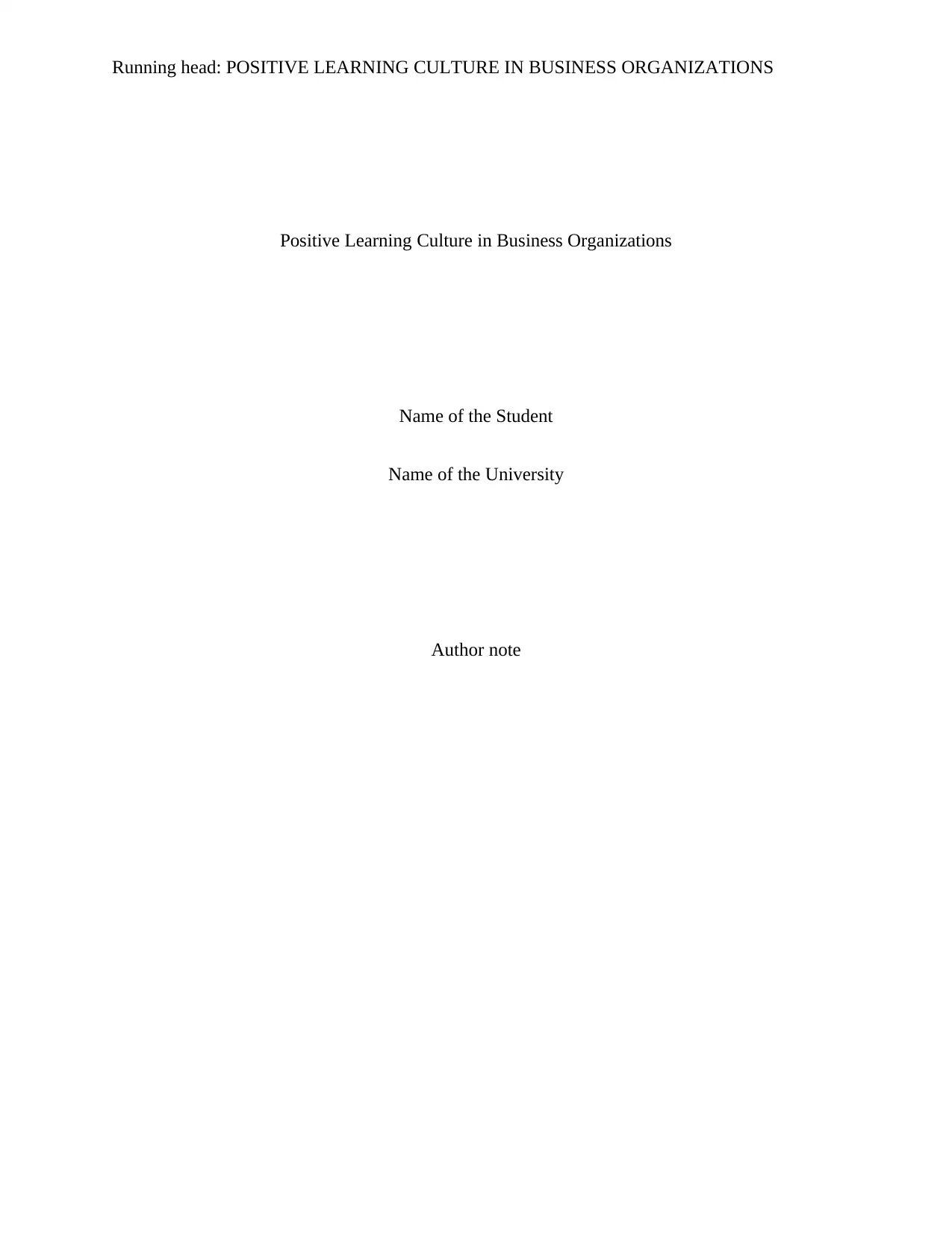
Running head: POSITIVE LEARNING CULTURE IN BUSINESS ORGANIZATIONS
Positive Learning Culture in Business Organizations
Name of the Student
Name of the University
Author note
Positive Learning Culture in Business Organizations
Name of the Student
Name of the University
Author note
Secure Best Marks with AI Grader
Need help grading? Try our AI Grader for instant feedback on your assignments.
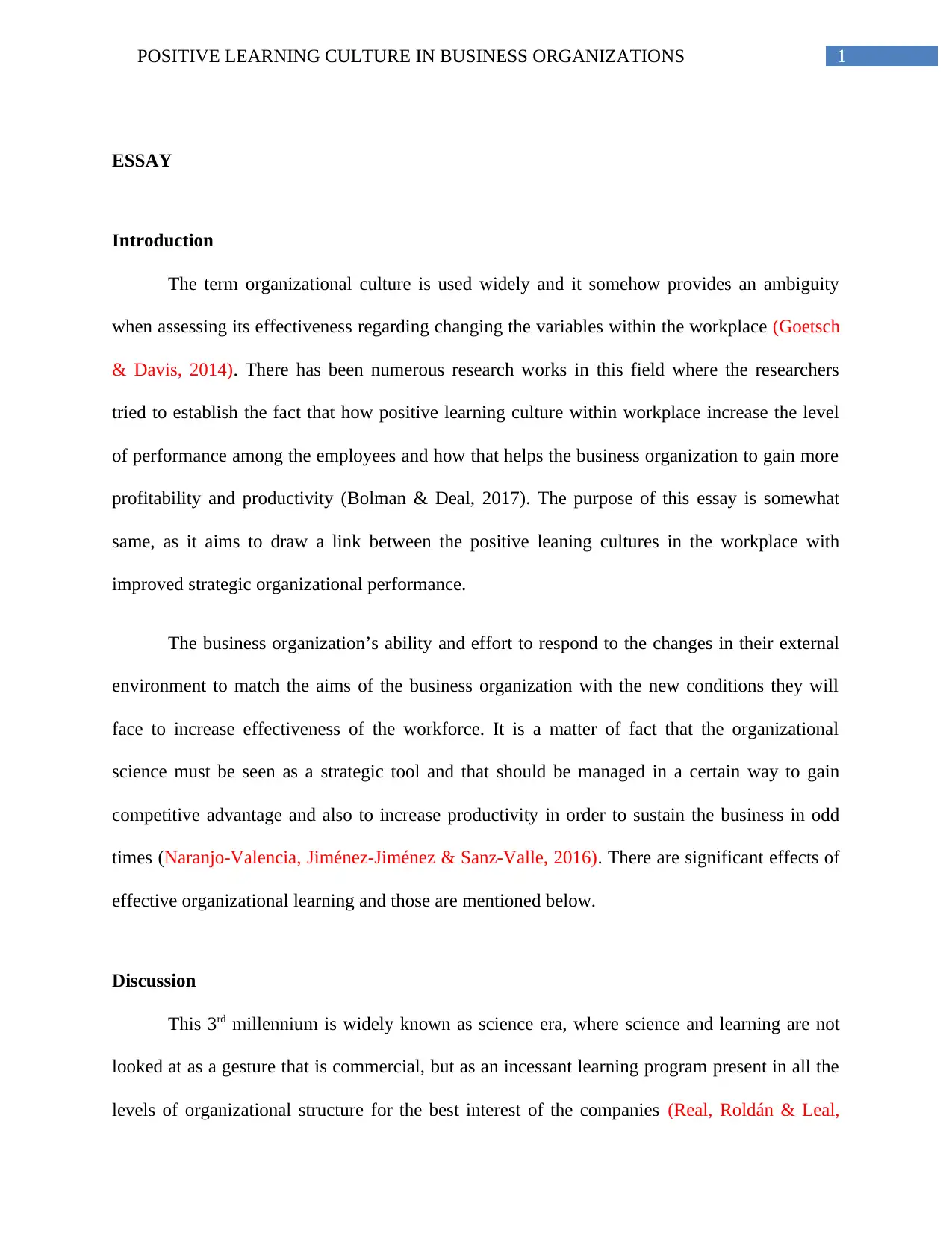
1POSITIVE LEARNING CULTURE IN BUSINESS ORGANIZATIONS
ESSAY
Introduction
The term organizational culture is used widely and it somehow provides an ambiguity
when assessing its effectiveness regarding changing the variables within the workplace (Goetsch
& Davis, 2014). There has been numerous research works in this field where the researchers
tried to establish the fact that how positive learning culture within workplace increase the level
of performance among the employees and how that helps the business organization to gain more
profitability and productivity (Bolman & Deal, 2017). The purpose of this essay is somewhat
same, as it aims to draw a link between the positive leaning cultures in the workplace with
improved strategic organizational performance.
The business organization’s ability and effort to respond to the changes in their external
environment to match the aims of the business organization with the new conditions they will
face to increase effectiveness of the workforce. It is a matter of fact that the organizational
science must be seen as a strategic tool and that should be managed in a certain way to gain
competitive advantage and also to increase productivity in order to sustain the business in odd
times (Naranjo-Valencia, Jiménez-Jiménez & Sanz-Valle, 2016). There are significant effects of
effective organizational learning and those are mentioned below.
Discussion
This 3rd millennium is widely known as science era, where science and learning are not
looked at as a gesture that is commercial, but as an incessant learning program present in all the
levels of organizational structure for the best interest of the companies (Real, Roldán & Leal,
ESSAY
Introduction
The term organizational culture is used widely and it somehow provides an ambiguity
when assessing its effectiveness regarding changing the variables within the workplace (Goetsch
& Davis, 2014). There has been numerous research works in this field where the researchers
tried to establish the fact that how positive learning culture within workplace increase the level
of performance among the employees and how that helps the business organization to gain more
profitability and productivity (Bolman & Deal, 2017). The purpose of this essay is somewhat
same, as it aims to draw a link between the positive leaning cultures in the workplace with
improved strategic organizational performance.
The business organization’s ability and effort to respond to the changes in their external
environment to match the aims of the business organization with the new conditions they will
face to increase effectiveness of the workforce. It is a matter of fact that the organizational
science must be seen as a strategic tool and that should be managed in a certain way to gain
competitive advantage and also to increase productivity in order to sustain the business in odd
times (Naranjo-Valencia, Jiménez-Jiménez & Sanz-Valle, 2016). There are significant effects of
effective organizational learning and those are mentioned below.
Discussion
This 3rd millennium is widely known as science era, where science and learning are not
looked at as a gesture that is commercial, but as an incessant learning program present in all the
levels of organizational structure for the best interest of the companies (Real, Roldán & Leal,
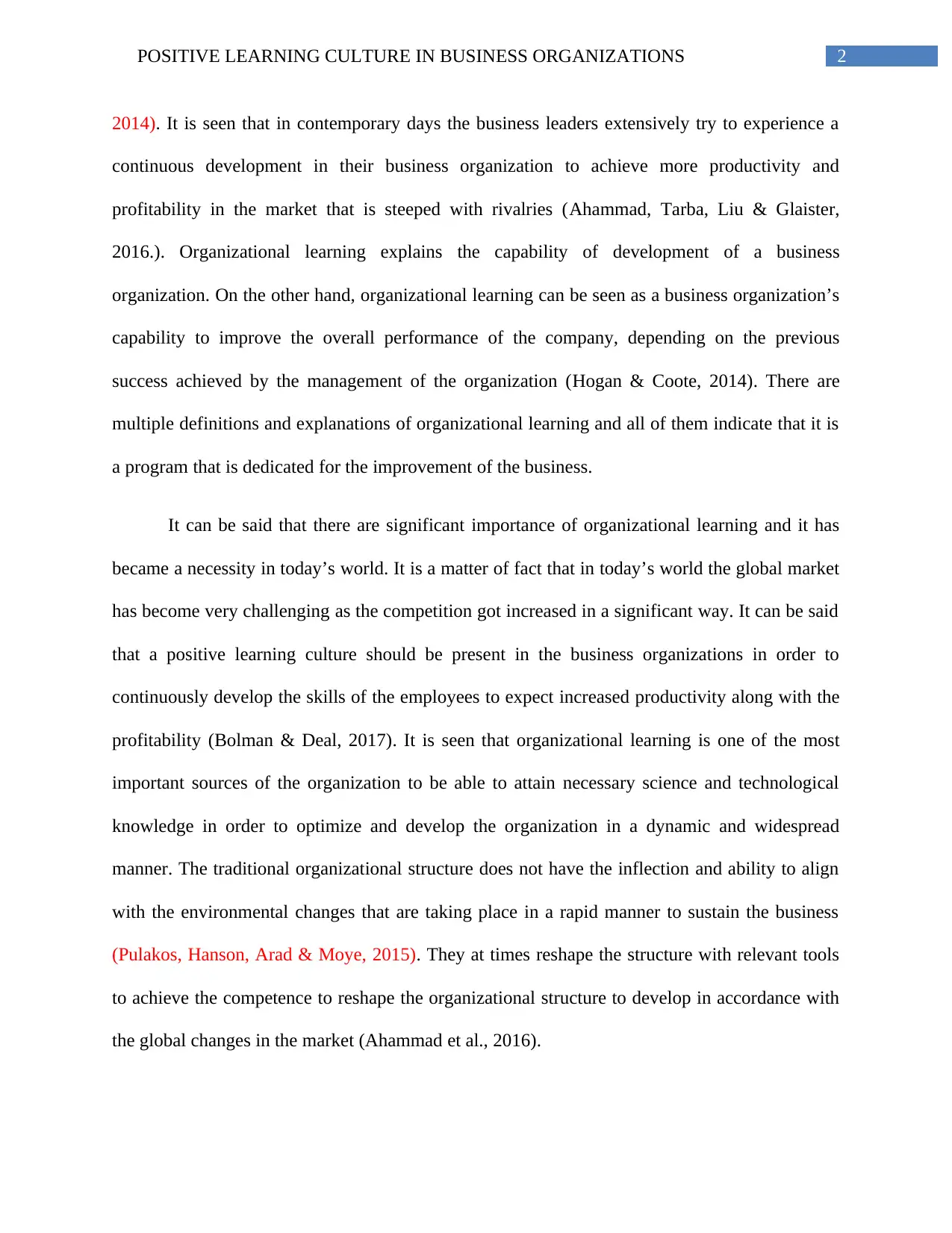
2POSITIVE LEARNING CULTURE IN BUSINESS ORGANIZATIONS
2014). It is seen that in contemporary days the business leaders extensively try to experience a
continuous development in their business organization to achieve more productivity and
profitability in the market that is steeped with rivalries (Ahammad, Tarba, Liu & Glaister,
2016.). Organizational learning explains the capability of development of a business
organization. On the other hand, organizational learning can be seen as a business organization’s
capability to improve the overall performance of the company, depending on the previous
success achieved by the management of the organization (Hogan & Coote, 2014). There are
multiple definitions and explanations of organizational learning and all of them indicate that it is
a program that is dedicated for the improvement of the business.
It can be said that there are significant importance of organizational learning and it has
became a necessity in today’s world. It is a matter of fact that in today’s world the global market
has become very challenging as the competition got increased in a significant way. It can be said
that a positive learning culture should be present in the business organizations in order to
continuously develop the skills of the employees to expect increased productivity along with the
profitability (Bolman & Deal, 2017). It is seen that organizational learning is one of the most
important sources of the organization to be able to attain necessary science and technological
knowledge in order to optimize and develop the organization in a dynamic and widespread
manner. The traditional organizational structure does not have the inflection and ability to align
with the environmental changes that are taking place in a rapid manner to sustain the business
(Pulakos, Hanson, Arad & Moye, 2015). They at times reshape the structure with relevant tools
to achieve the competence to reshape the organizational structure to develop in accordance with
the global changes in the market (Ahammad et al., 2016).
2014). It is seen that in contemporary days the business leaders extensively try to experience a
continuous development in their business organization to achieve more productivity and
profitability in the market that is steeped with rivalries (Ahammad, Tarba, Liu & Glaister,
2016.). Organizational learning explains the capability of development of a business
organization. On the other hand, organizational learning can be seen as a business organization’s
capability to improve the overall performance of the company, depending on the previous
success achieved by the management of the organization (Hogan & Coote, 2014). There are
multiple definitions and explanations of organizational learning and all of them indicate that it is
a program that is dedicated for the improvement of the business.
It can be said that there are significant importance of organizational learning and it has
became a necessity in today’s world. It is a matter of fact that in today’s world the global market
has become very challenging as the competition got increased in a significant way. It can be said
that a positive learning culture should be present in the business organizations in order to
continuously develop the skills of the employees to expect increased productivity along with the
profitability (Bolman & Deal, 2017). It is seen that organizational learning is one of the most
important sources of the organization to be able to attain necessary science and technological
knowledge in order to optimize and develop the organization in a dynamic and widespread
manner. The traditional organizational structure does not have the inflection and ability to align
with the environmental changes that are taking place in a rapid manner to sustain the business
(Pulakos, Hanson, Arad & Moye, 2015). They at times reshape the structure with relevant tools
to achieve the competence to reshape the organizational structure to develop in accordance with
the global changes in the market (Ahammad et al., 2016).
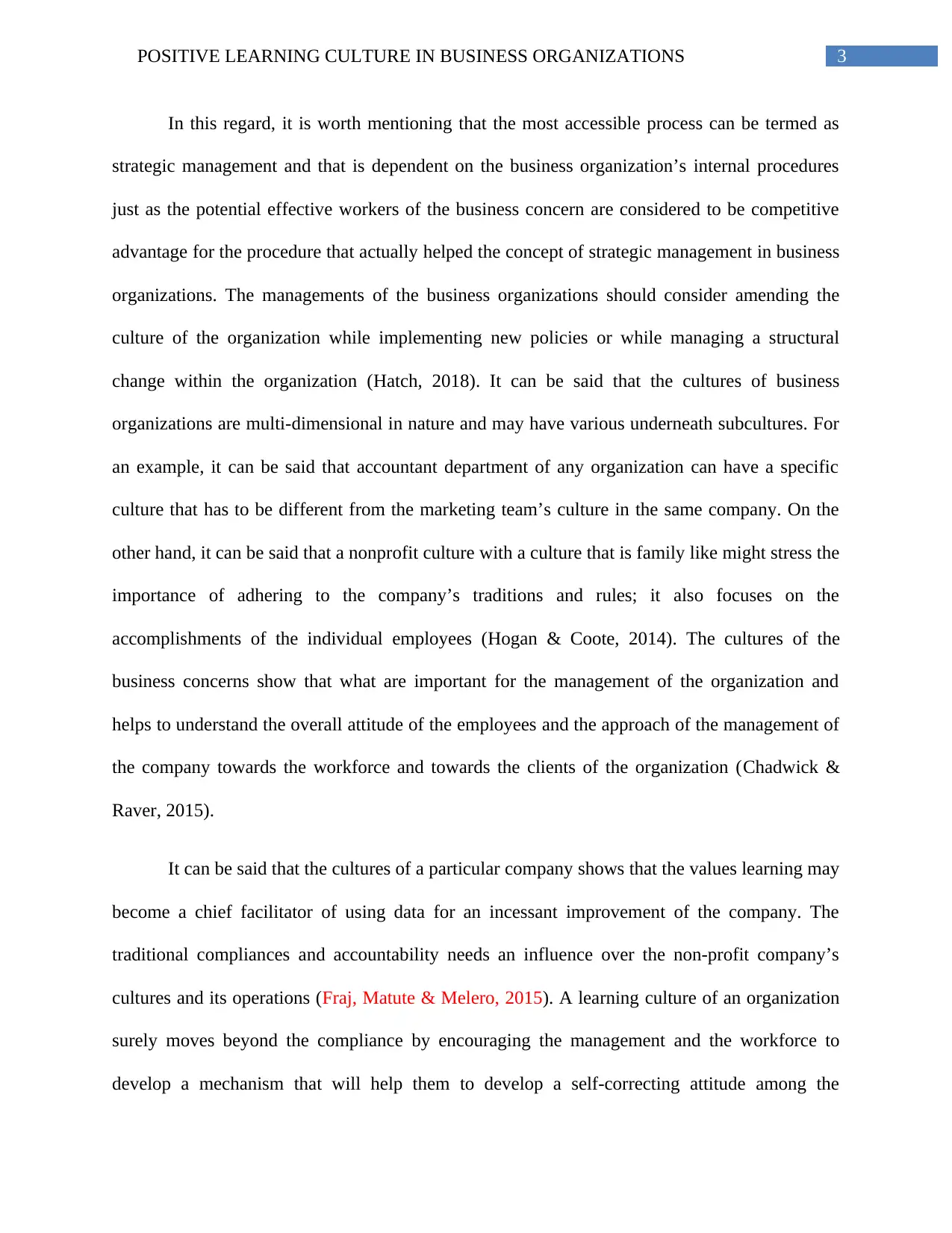
3POSITIVE LEARNING CULTURE IN BUSINESS ORGANIZATIONS
In this regard, it is worth mentioning that the most accessible process can be termed as
strategic management and that is dependent on the business organization’s internal procedures
just as the potential effective workers of the business concern are considered to be competitive
advantage for the procedure that actually helped the concept of strategic management in business
organizations. The managements of the business organizations should consider amending the
culture of the organization while implementing new policies or while managing a structural
change within the organization (Hatch, 2018). It can be said that the cultures of business
organizations are multi-dimensional in nature and may have various underneath subcultures. For
an example, it can be said that accountant department of any organization can have a specific
culture that has to be different from the marketing team’s culture in the same company. On the
other hand, it can be said that a nonprofit culture with a culture that is family like might stress the
importance of adhering to the company’s traditions and rules; it also focuses on the
accomplishments of the individual employees (Hogan & Coote, 2014). The cultures of the
business concerns show that what are important for the management of the organization and
helps to understand the overall attitude of the employees and the approach of the management of
the company towards the workforce and towards the clients of the organization (Chadwick &
Raver, 2015).
It can be said that the cultures of a particular company shows that the values learning may
become a chief facilitator of using data for an incessant improvement of the company. The
traditional compliances and accountability needs an influence over the non-profit company’s
cultures and its operations (Fraj, Matute & Melero, 2015). A learning culture of an organization
surely moves beyond the compliance by encouraging the management and the workforce to
develop a mechanism that will help them to develop a self-correcting attitude among the
In this regard, it is worth mentioning that the most accessible process can be termed as
strategic management and that is dependent on the business organization’s internal procedures
just as the potential effective workers of the business concern are considered to be competitive
advantage for the procedure that actually helped the concept of strategic management in business
organizations. The managements of the business organizations should consider amending the
culture of the organization while implementing new policies or while managing a structural
change within the organization (Hatch, 2018). It can be said that the cultures of business
organizations are multi-dimensional in nature and may have various underneath subcultures. For
an example, it can be said that accountant department of any organization can have a specific
culture that has to be different from the marketing team’s culture in the same company. On the
other hand, it can be said that a nonprofit culture with a culture that is family like might stress the
importance of adhering to the company’s traditions and rules; it also focuses on the
accomplishments of the individual employees (Hogan & Coote, 2014). The cultures of the
business concerns show that what are important for the management of the organization and
helps to understand the overall attitude of the employees and the approach of the management of
the company towards the workforce and towards the clients of the organization (Chadwick &
Raver, 2015).
It can be said that the cultures of a particular company shows that the values learning may
become a chief facilitator of using data for an incessant improvement of the company. The
traditional compliances and accountability needs an influence over the non-profit company’s
cultures and its operations (Fraj, Matute & Melero, 2015). A learning culture of an organization
surely moves beyond the compliance by encouraging the management and the workforce to
develop a mechanism that will help them to develop a self-correcting attitude among the
Secure Best Marks with AI Grader
Need help grading? Try our AI Grader for instant feedback on your assignments.
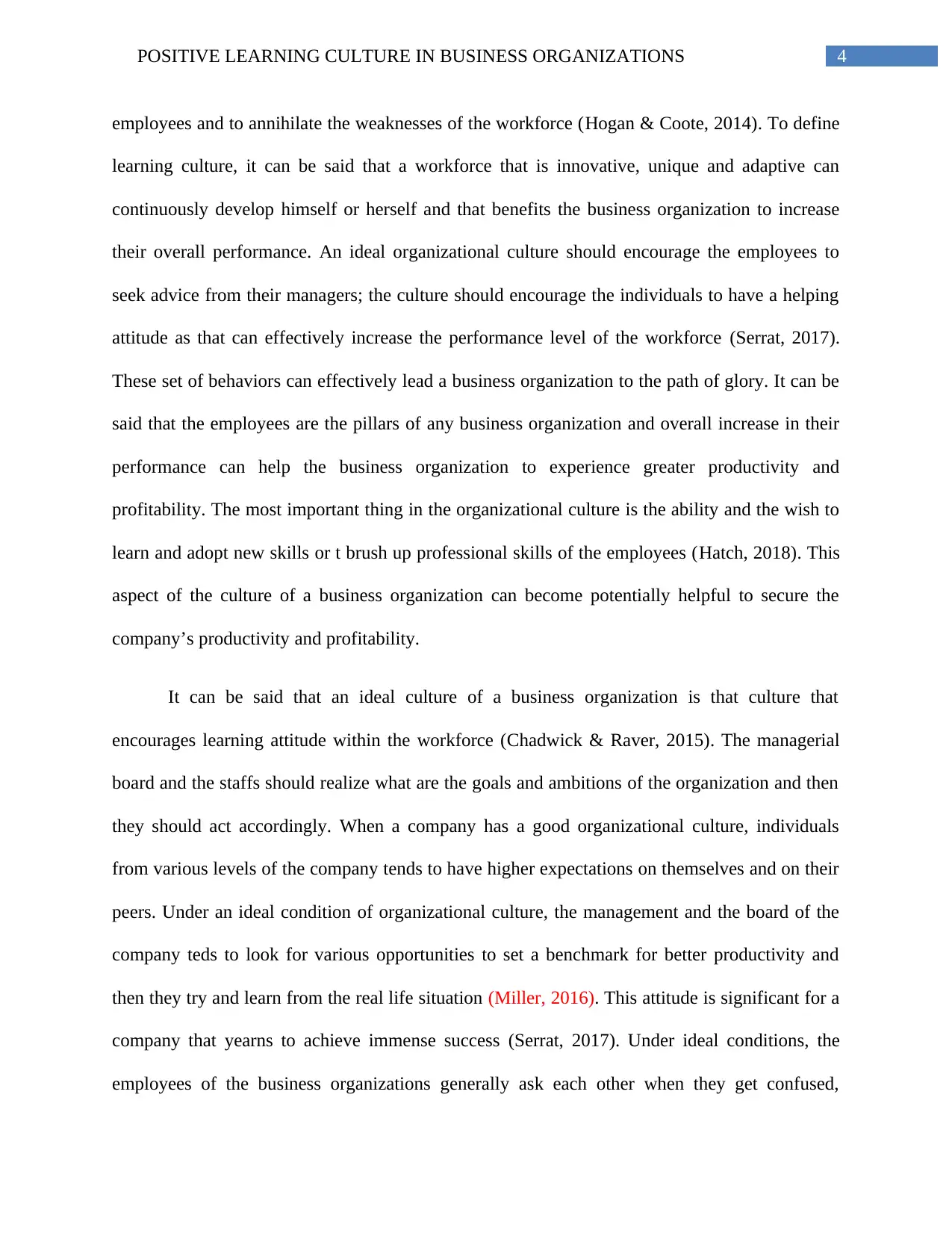
4POSITIVE LEARNING CULTURE IN BUSINESS ORGANIZATIONS
employees and to annihilate the weaknesses of the workforce (Hogan & Coote, 2014). To define
learning culture, it can be said that a workforce that is innovative, unique and adaptive can
continuously develop himself or herself and that benefits the business organization to increase
their overall performance. An ideal organizational culture should encourage the employees to
seek advice from their managers; the culture should encourage the individuals to have a helping
attitude as that can effectively increase the performance level of the workforce (Serrat, 2017).
These set of behaviors can effectively lead a business organization to the path of glory. It can be
said that the employees are the pillars of any business organization and overall increase in their
performance can help the business organization to experience greater productivity and
profitability. The most important thing in the organizational culture is the ability and the wish to
learn and adopt new skills or t brush up professional skills of the employees (Hatch, 2018). This
aspect of the culture of a business organization can become potentially helpful to secure the
company’s productivity and profitability.
It can be said that an ideal culture of a business organization is that culture that
encourages learning attitude within the workforce (Chadwick & Raver, 2015). The managerial
board and the staffs should realize what are the goals and ambitions of the organization and then
they should act accordingly. When a company has a good organizational culture, individuals
from various levels of the company tends to have higher expectations on themselves and on their
peers. Under an ideal condition of organizational culture, the management and the board of the
company teds to look for various opportunities to set a benchmark for better productivity and
then they try and learn from the real life situation (Miller, 2016). This attitude is significant for a
company that yearns to achieve immense success (Serrat, 2017). Under ideal conditions, the
employees of the business organizations generally ask each other when they get confused,
employees and to annihilate the weaknesses of the workforce (Hogan & Coote, 2014). To define
learning culture, it can be said that a workforce that is innovative, unique and adaptive can
continuously develop himself or herself and that benefits the business organization to increase
their overall performance. An ideal organizational culture should encourage the employees to
seek advice from their managers; the culture should encourage the individuals to have a helping
attitude as that can effectively increase the performance level of the workforce (Serrat, 2017).
These set of behaviors can effectively lead a business organization to the path of glory. It can be
said that the employees are the pillars of any business organization and overall increase in their
performance can help the business organization to experience greater productivity and
profitability. The most important thing in the organizational culture is the ability and the wish to
learn and adopt new skills or t brush up professional skills of the employees (Hatch, 2018). This
aspect of the culture of a business organization can become potentially helpful to secure the
company’s productivity and profitability.
It can be said that an ideal culture of a business organization is that culture that
encourages learning attitude within the workforce (Chadwick & Raver, 2015). The managerial
board and the staffs should realize what are the goals and ambitions of the organization and then
they should act accordingly. When a company has a good organizational culture, individuals
from various levels of the company tends to have higher expectations on themselves and on their
peers. Under an ideal condition of organizational culture, the management and the board of the
company teds to look for various opportunities to set a benchmark for better productivity and
then they try and learn from the real life situation (Miller, 2016). This attitude is significant for a
company that yearns to achieve immense success (Serrat, 2017). Under ideal conditions, the
employees of the business organizations generally ask each other when they get confused,
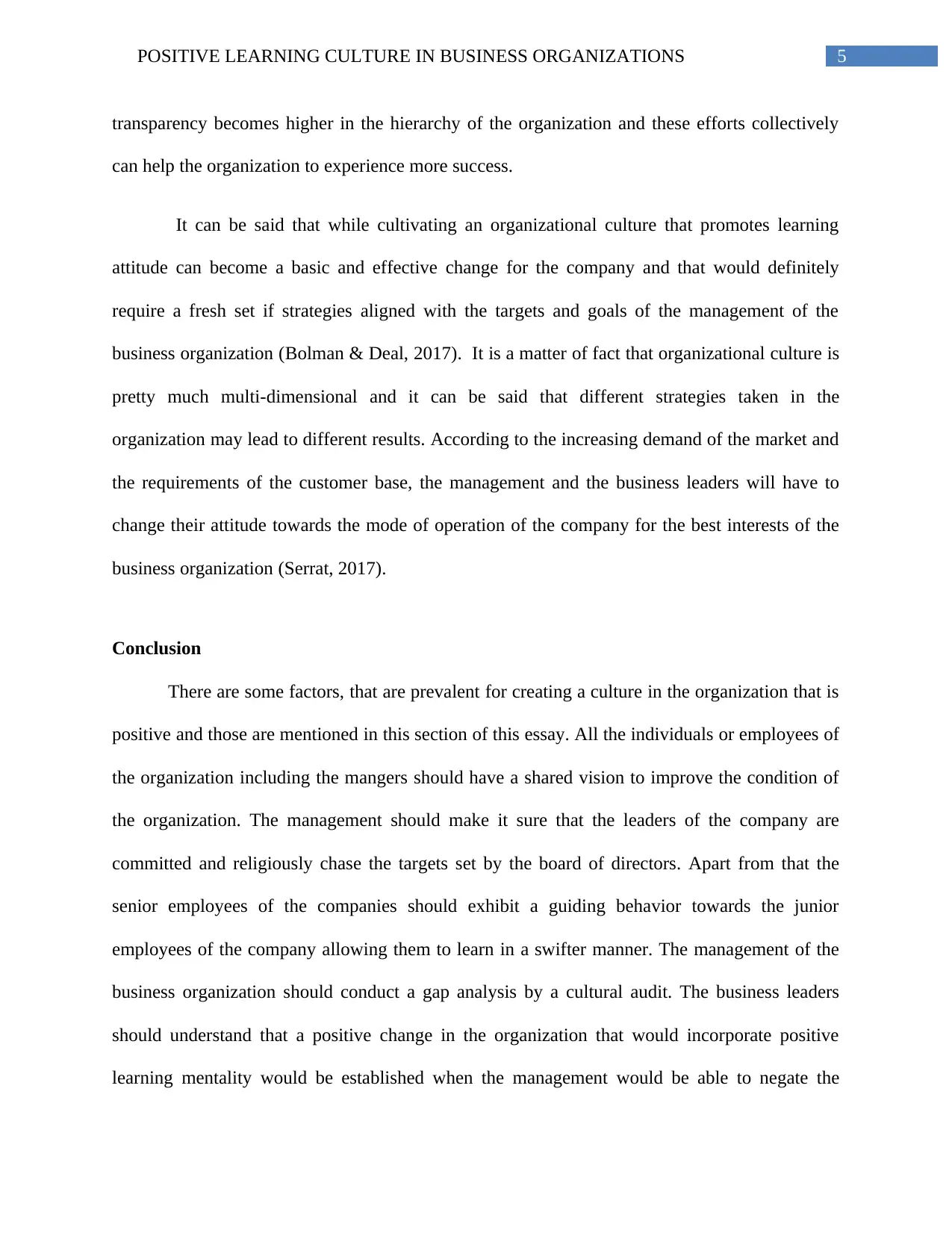
5POSITIVE LEARNING CULTURE IN BUSINESS ORGANIZATIONS
transparency becomes higher in the hierarchy of the organization and these efforts collectively
can help the organization to experience more success.
It can be said that while cultivating an organizational culture that promotes learning
attitude can become a basic and effective change for the company and that would definitely
require a fresh set if strategies aligned with the targets and goals of the management of the
business organization (Bolman & Deal, 2017). It is a matter of fact that organizational culture is
pretty much multi-dimensional and it can be said that different strategies taken in the
organization may lead to different results. According to the increasing demand of the market and
the requirements of the customer base, the management and the business leaders will have to
change their attitude towards the mode of operation of the company for the best interests of the
business organization (Serrat, 2017).
Conclusion
There are some factors, that are prevalent for creating a culture in the organization that is
positive and those are mentioned in this section of this essay. All the individuals or employees of
the organization including the mangers should have a shared vision to improve the condition of
the organization. The management should make it sure that the leaders of the company are
committed and religiously chase the targets set by the board of directors. Apart from that the
senior employees of the companies should exhibit a guiding behavior towards the junior
employees of the company allowing them to learn in a swifter manner. The management of the
business organization should conduct a gap analysis by a cultural audit. The business leaders
should understand that a positive change in the organization that would incorporate positive
learning mentality would be established when the management would be able to negate the
transparency becomes higher in the hierarchy of the organization and these efforts collectively
can help the organization to experience more success.
It can be said that while cultivating an organizational culture that promotes learning
attitude can become a basic and effective change for the company and that would definitely
require a fresh set if strategies aligned with the targets and goals of the management of the
business organization (Bolman & Deal, 2017). It is a matter of fact that organizational culture is
pretty much multi-dimensional and it can be said that different strategies taken in the
organization may lead to different results. According to the increasing demand of the market and
the requirements of the customer base, the management and the business leaders will have to
change their attitude towards the mode of operation of the company for the best interests of the
business organization (Serrat, 2017).
Conclusion
There are some factors, that are prevalent for creating a culture in the organization that is
positive and those are mentioned in this section of this essay. All the individuals or employees of
the organization including the mangers should have a shared vision to improve the condition of
the organization. The management should make it sure that the leaders of the company are
committed and religiously chase the targets set by the board of directors. Apart from that the
senior employees of the companies should exhibit a guiding behavior towards the junior
employees of the company allowing them to learn in a swifter manner. The management of the
business organization should conduct a gap analysis by a cultural audit. The business leaders
should understand that a positive change in the organization that would incorporate positive
learning mentality would be established when the management would be able to negate the
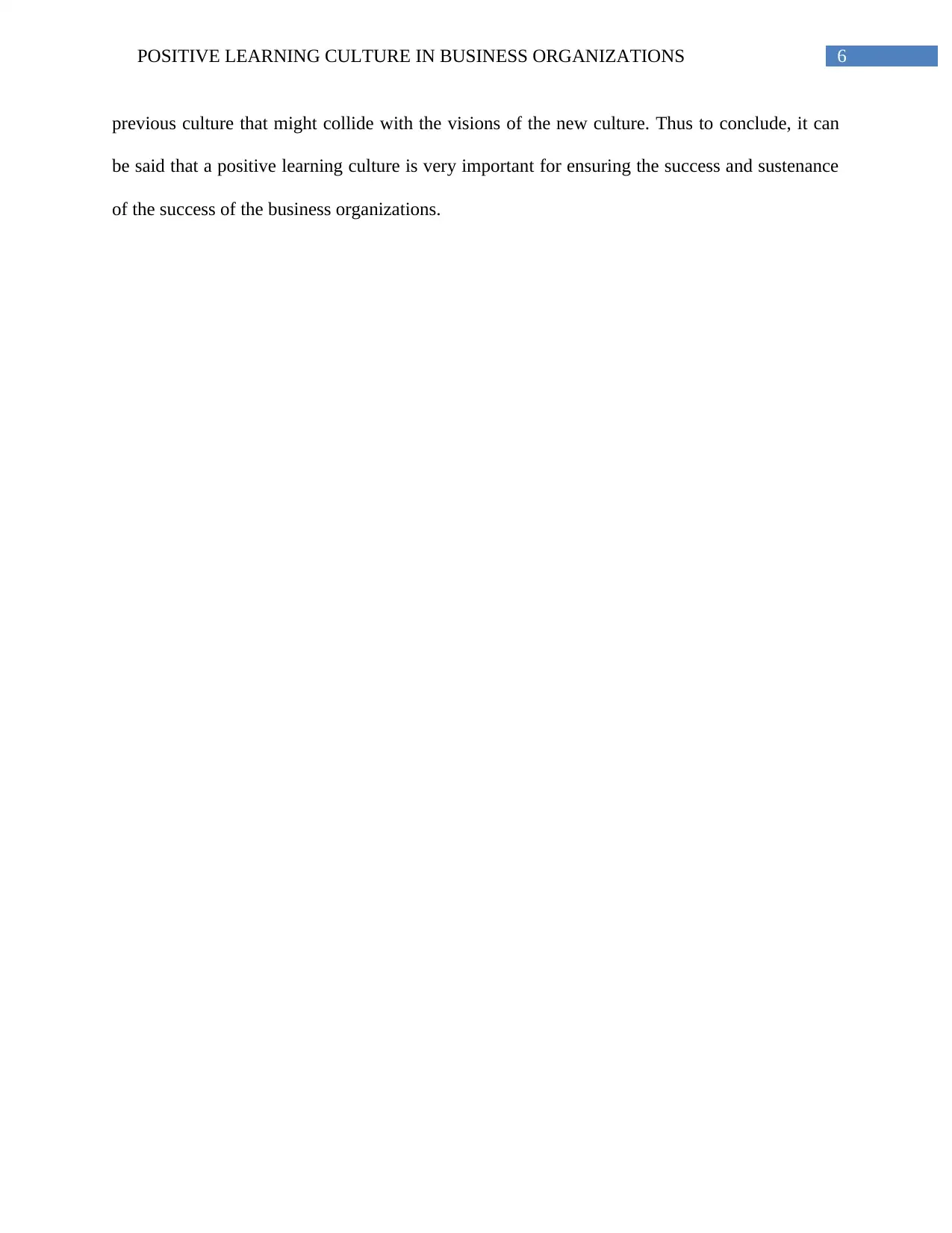
6POSITIVE LEARNING CULTURE IN BUSINESS ORGANIZATIONS
previous culture that might collide with the visions of the new culture. Thus to conclude, it can
be said that a positive learning culture is very important for ensuring the success and sustenance
of the success of the business organizations.
previous culture that might collide with the visions of the new culture. Thus to conclude, it can
be said that a positive learning culture is very important for ensuring the success and sustenance
of the success of the business organizations.
Paraphrase This Document
Need a fresh take? Get an instant paraphrase of this document with our AI Paraphraser
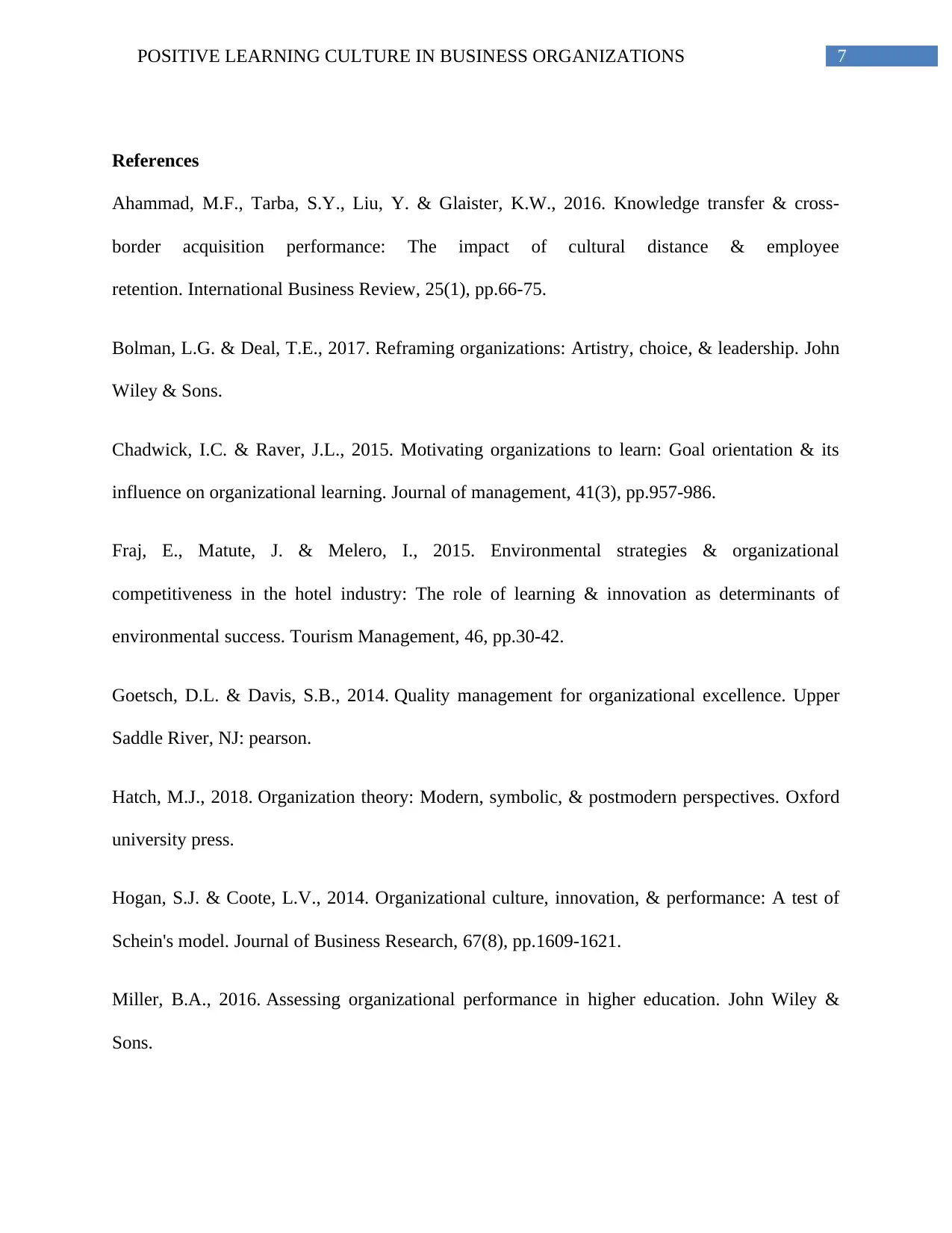
7POSITIVE LEARNING CULTURE IN BUSINESS ORGANIZATIONS
References
Ahammad, M.F., Tarba, S.Y., Liu, Y. & Glaister, K.W., 2016. Knowledge transfer & cross-
border acquisition performance: The impact of cultural distance & employee
retention. International Business Review, 25(1), pp.66-75.
Bolman, L.G. & Deal, T.E., 2017. Reframing organizations: Artistry, choice, & leadership. John
Wiley & Sons.
Chadwick, I.C. & Raver, J.L., 2015. Motivating organizations to learn: Goal orientation & its
influence on organizational learning. Journal of management, 41(3), pp.957-986.
Fraj, E., Matute, J. & Melero, I., 2015. Environmental strategies & organizational
competitiveness in the hotel industry: The role of learning & innovation as determinants of
environmental success. Tourism Management, 46, pp.30-42.
Goetsch, D.L. & Davis, S.B., 2014. Quality management for organizational excellence. Upper
Saddle River, NJ: pearson.
Hatch, M.J., 2018. Organization theory: Modern, symbolic, & postmodern perspectives. Oxford
university press.
Hogan, S.J. & Coote, L.V., 2014. Organizational culture, innovation, & performance: A test of
Schein's model. Journal of Business Research, 67(8), pp.1609-1621.
Miller, B.A., 2016. Assessing organizational performance in higher education. John Wiley &
Sons.
References
Ahammad, M.F., Tarba, S.Y., Liu, Y. & Glaister, K.W., 2016. Knowledge transfer & cross-
border acquisition performance: The impact of cultural distance & employee
retention. International Business Review, 25(1), pp.66-75.
Bolman, L.G. & Deal, T.E., 2017. Reframing organizations: Artistry, choice, & leadership. John
Wiley & Sons.
Chadwick, I.C. & Raver, J.L., 2015. Motivating organizations to learn: Goal orientation & its
influence on organizational learning. Journal of management, 41(3), pp.957-986.
Fraj, E., Matute, J. & Melero, I., 2015. Environmental strategies & organizational
competitiveness in the hotel industry: The role of learning & innovation as determinants of
environmental success. Tourism Management, 46, pp.30-42.
Goetsch, D.L. & Davis, S.B., 2014. Quality management for organizational excellence. Upper
Saddle River, NJ: pearson.
Hatch, M.J., 2018. Organization theory: Modern, symbolic, & postmodern perspectives. Oxford
university press.
Hogan, S.J. & Coote, L.V., 2014. Organizational culture, innovation, & performance: A test of
Schein's model. Journal of Business Research, 67(8), pp.1609-1621.
Miller, B.A., 2016. Assessing organizational performance in higher education. John Wiley &
Sons.
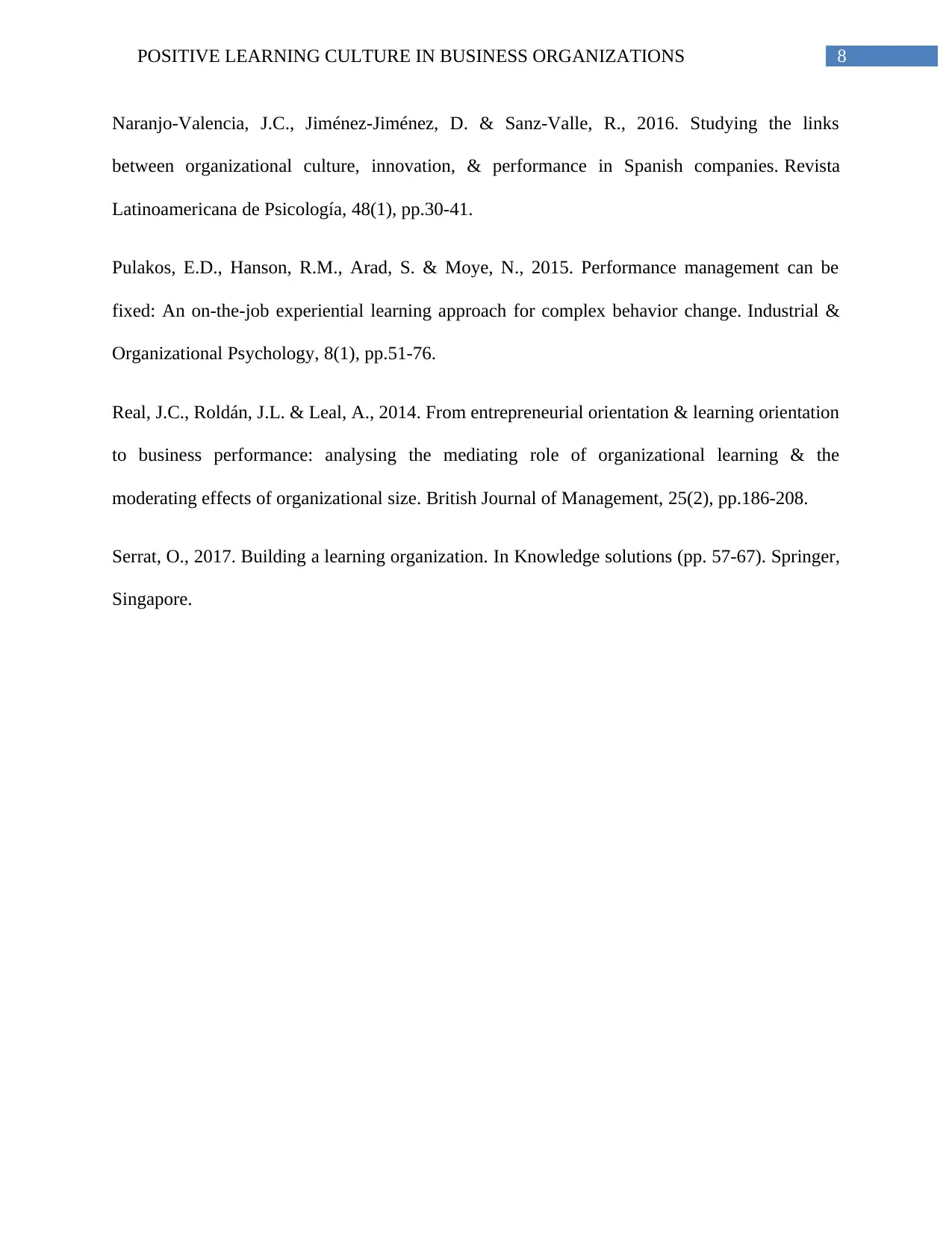
8POSITIVE LEARNING CULTURE IN BUSINESS ORGANIZATIONS
Naranjo-Valencia, J.C., Jiménez-Jiménez, D. & Sanz-Valle, R., 2016. Studying the links
between organizational culture, innovation, & performance in Spanish companies. Revista
Latinoamericana de Psicología, 48(1), pp.30-41.
Pulakos, E.D., Hanson, R.M., Arad, S. & Moye, N., 2015. Performance management can be
fixed: An on-the-job experiential learning approach for complex behavior change. Industrial &
Organizational Psychology, 8(1), pp.51-76.
Real, J.C., Roldán, J.L. & Leal, A., 2014. From entrepreneurial orientation & learning orientation
to business performance: analysing the mediating role of organizational learning & the
moderating effects of organizational size. British Journal of Management, 25(2), pp.186-208.
Serrat, O., 2017. Building a learning organization. In Knowledge solutions (pp. 57-67). Springer,
Singapore.
Naranjo-Valencia, J.C., Jiménez-Jiménez, D. & Sanz-Valle, R., 2016. Studying the links
between organizational culture, innovation, & performance in Spanish companies. Revista
Latinoamericana de Psicología, 48(1), pp.30-41.
Pulakos, E.D., Hanson, R.M., Arad, S. & Moye, N., 2015. Performance management can be
fixed: An on-the-job experiential learning approach for complex behavior change. Industrial &
Organizational Psychology, 8(1), pp.51-76.
Real, J.C., Roldán, J.L. & Leal, A., 2014. From entrepreneurial orientation & learning orientation
to business performance: analysing the mediating role of organizational learning & the
moderating effects of organizational size. British Journal of Management, 25(2), pp.186-208.
Serrat, O., 2017. Building a learning organization. In Knowledge solutions (pp. 57-67). Springer,
Singapore.
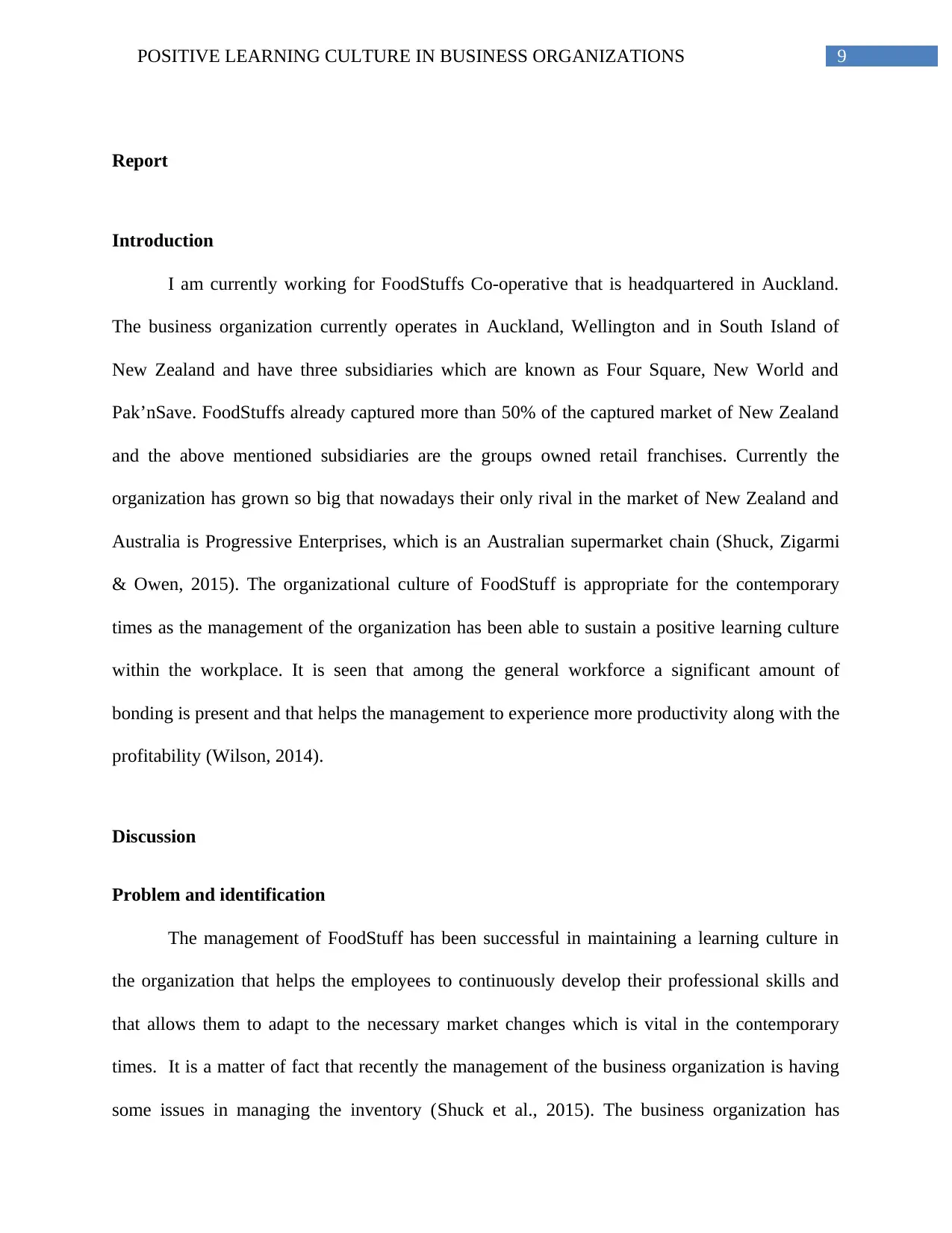
9POSITIVE LEARNING CULTURE IN BUSINESS ORGANIZATIONS
Report
Introduction
I am currently working for FoodStuffs Co-operative that is headquartered in Auckland.
The business organization currently operates in Auckland, Wellington and in South Island of
New Zealand and have three subsidiaries which are known as Four Square, New World and
Pak’nSave. FoodStuffs already captured more than 50% of the captured market of New Zealand
and the above mentioned subsidiaries are the groups owned retail franchises. Currently the
organization has grown so big that nowadays their only rival in the market of New Zealand and
Australia is Progressive Enterprises, which is an Australian supermarket chain (Shuck, Zigarmi
& Owen, 2015). The organizational culture of FoodStuff is appropriate for the contemporary
times as the management of the organization has been able to sustain a positive learning culture
within the workplace. It is seen that among the general workforce a significant amount of
bonding is present and that helps the management to experience more productivity along with the
profitability (Wilson, 2014).
Discussion
Problem and identification
The management of FoodStuff has been successful in maintaining a learning culture in
the organization that helps the employees to continuously develop their professional skills and
that allows them to adapt to the necessary market changes which is vital in the contemporary
times. It is a matter of fact that recently the management of the business organization is having
some issues in managing the inventory (Shuck et al., 2015). The business organization has
Report
Introduction
I am currently working for FoodStuffs Co-operative that is headquartered in Auckland.
The business organization currently operates in Auckland, Wellington and in South Island of
New Zealand and have three subsidiaries which are known as Four Square, New World and
Pak’nSave. FoodStuffs already captured more than 50% of the captured market of New Zealand
and the above mentioned subsidiaries are the groups owned retail franchises. Currently the
organization has grown so big that nowadays their only rival in the market of New Zealand and
Australia is Progressive Enterprises, which is an Australian supermarket chain (Shuck, Zigarmi
& Owen, 2015). The organizational culture of FoodStuff is appropriate for the contemporary
times as the management of the organization has been able to sustain a positive learning culture
within the workplace. It is seen that among the general workforce a significant amount of
bonding is present and that helps the management to experience more productivity along with the
profitability (Wilson, 2014).
Discussion
Problem and identification
The management of FoodStuff has been successful in maintaining a learning culture in
the organization that helps the employees to continuously develop their professional skills and
that allows them to adapt to the necessary market changes which is vital in the contemporary
times. It is a matter of fact that recently the management of the business organization is having
some issues in managing the inventory (Shuck et al., 2015). The business organization has
Secure Best Marks with AI Grader
Need help grading? Try our AI Grader for instant feedback on your assignments.
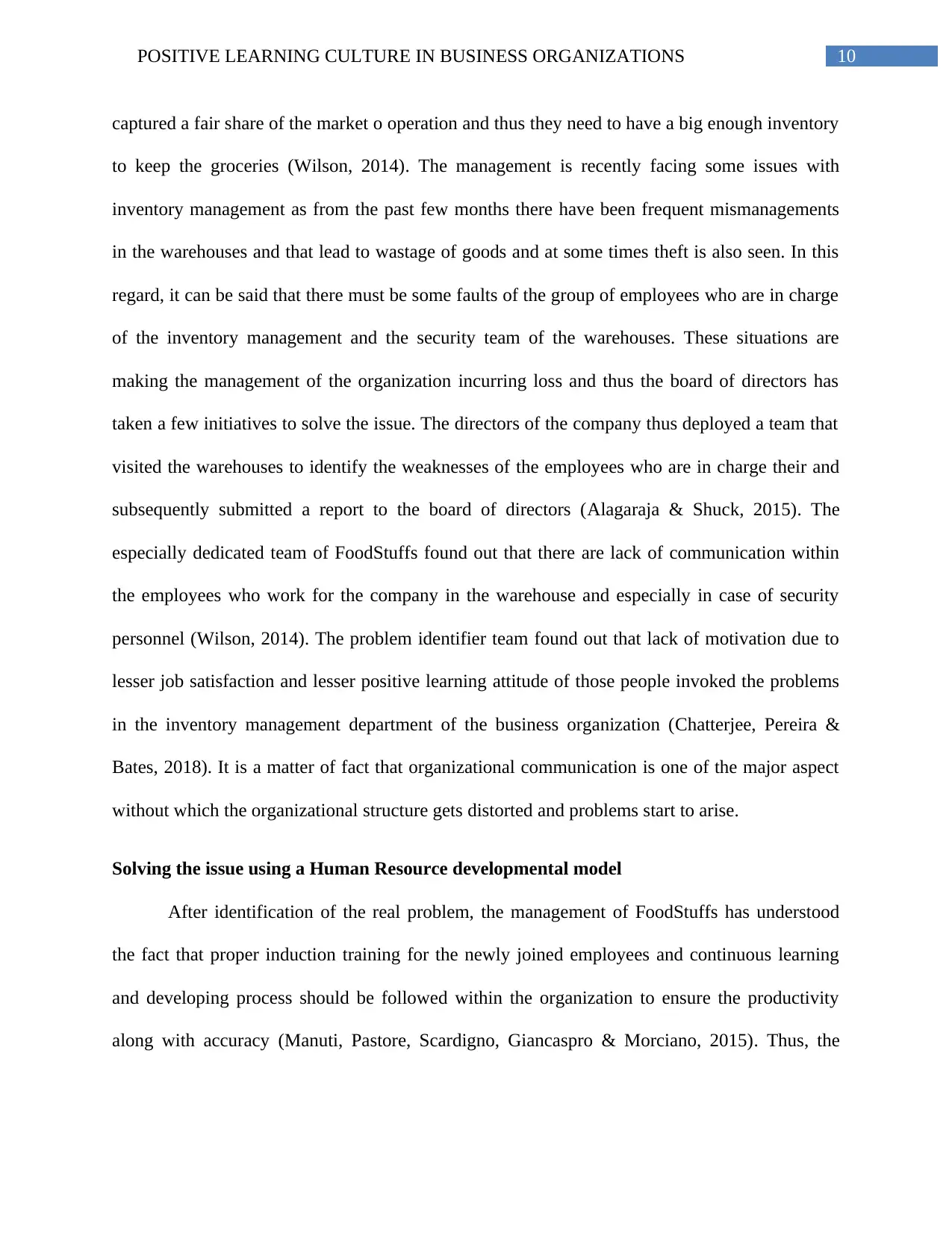
10POSITIVE LEARNING CULTURE IN BUSINESS ORGANIZATIONS
captured a fair share of the market o operation and thus they need to have a big enough inventory
to keep the groceries (Wilson, 2014). The management is recently facing some issues with
inventory management as from the past few months there have been frequent mismanagements
in the warehouses and that lead to wastage of goods and at some times theft is also seen. In this
regard, it can be said that there must be some faults of the group of employees who are in charge
of the inventory management and the security team of the warehouses. These situations are
making the management of the organization incurring loss and thus the board of directors has
taken a few initiatives to solve the issue. The directors of the company thus deployed a team that
visited the warehouses to identify the weaknesses of the employees who are in charge their and
subsequently submitted a report to the board of directors (Alagaraja & Shuck, 2015). The
especially dedicated team of FoodStuffs found out that there are lack of communication within
the employees who work for the company in the warehouse and especially in case of security
personnel (Wilson, 2014). The problem identifier team found out that lack of motivation due to
lesser job satisfaction and lesser positive learning attitude of those people invoked the problems
in the inventory management department of the business organization (Chatterjee, Pereira &
Bates, 2018). It is a matter of fact that organizational communication is one of the major aspect
without which the organizational structure gets distorted and problems start to arise.
Solving the issue using a Human Resource developmental model
After identification of the real problem, the management of FoodStuffs has understood
the fact that proper induction training for the newly joined employees and continuous learning
and developing process should be followed within the organization to ensure the productivity
along with accuracy (Manuti, Pastore, Scardigno, Giancaspro & Morciano, 2015). Thus, the
captured a fair share of the market o operation and thus they need to have a big enough inventory
to keep the groceries (Wilson, 2014). The management is recently facing some issues with
inventory management as from the past few months there have been frequent mismanagements
in the warehouses and that lead to wastage of goods and at some times theft is also seen. In this
regard, it can be said that there must be some faults of the group of employees who are in charge
of the inventory management and the security team of the warehouses. These situations are
making the management of the organization incurring loss and thus the board of directors has
taken a few initiatives to solve the issue. The directors of the company thus deployed a team that
visited the warehouses to identify the weaknesses of the employees who are in charge their and
subsequently submitted a report to the board of directors (Alagaraja & Shuck, 2015). The
especially dedicated team of FoodStuffs found out that there are lack of communication within
the employees who work for the company in the warehouse and especially in case of security
personnel (Wilson, 2014). The problem identifier team found out that lack of motivation due to
lesser job satisfaction and lesser positive learning attitude of those people invoked the problems
in the inventory management department of the business organization (Chatterjee, Pereira &
Bates, 2018). It is a matter of fact that organizational communication is one of the major aspect
without which the organizational structure gets distorted and problems start to arise.
Solving the issue using a Human Resource developmental model
After identification of the real problem, the management of FoodStuffs has understood
the fact that proper induction training for the newly joined employees and continuous learning
and developing process should be followed within the organization to ensure the productivity
along with accuracy (Manuti, Pastore, Scardigno, Giancaspro & Morciano, 2015). Thus, the
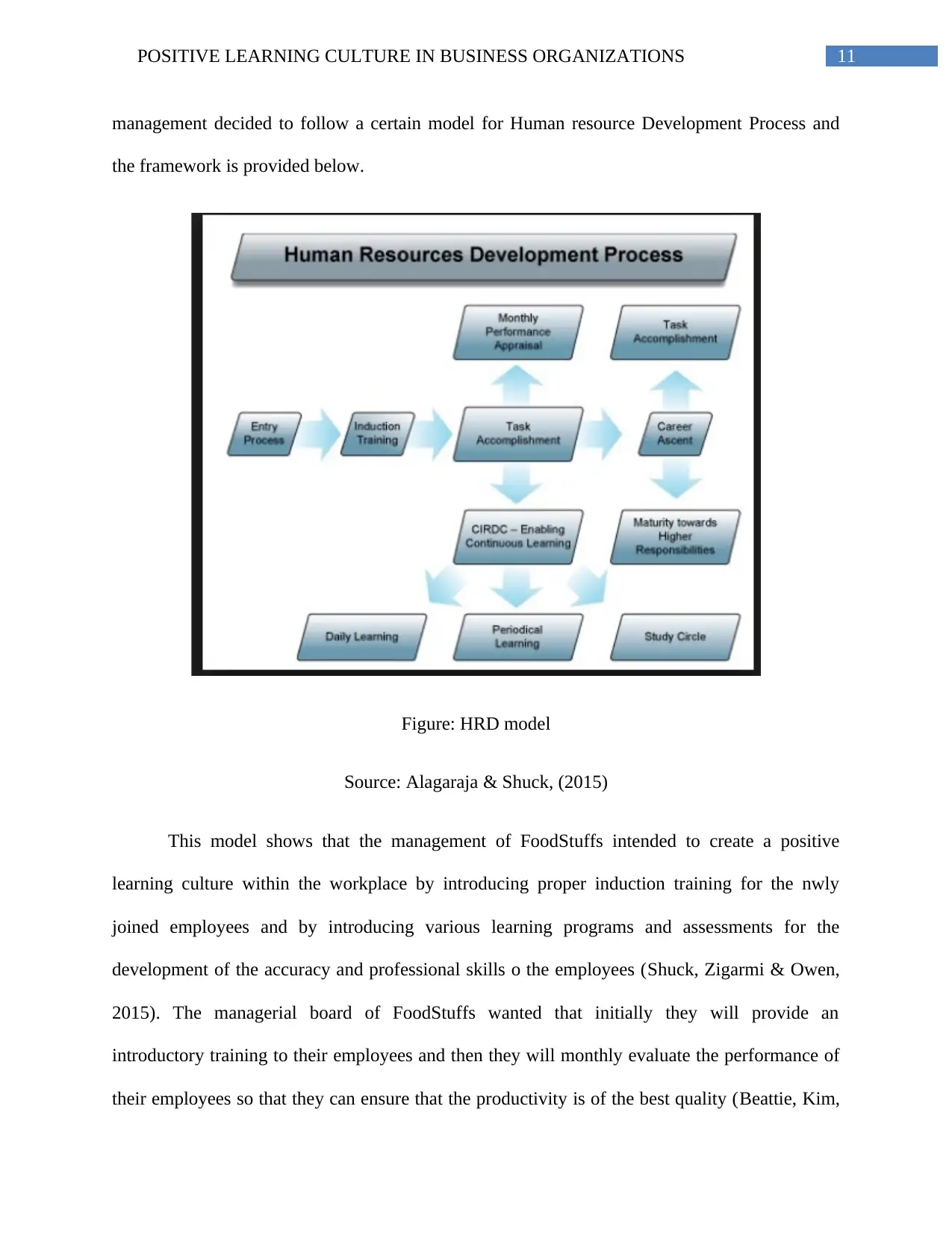
11POSITIVE LEARNING CULTURE IN BUSINESS ORGANIZATIONS
management decided to follow a certain model for Human resource Development Process and
the framework is provided below.
Figure: HRD model
Source: Alagaraja & Shuck, (2015)
This model shows that the management of FoodStuffs intended to create a positive
learning culture within the workplace by introducing proper induction training for the nwly
joined employees and by introducing various learning programs and assessments for the
development of the accuracy and professional skills o the employees (Shuck, Zigarmi & Owen,
2015). The managerial board of FoodStuffs wanted that initially they will provide an
introductory training to their employees and then they will monthly evaluate the performance of
their employees so that they can ensure that the productivity is of the best quality (Beattie, Kim,
management decided to follow a certain model for Human resource Development Process and
the framework is provided below.
Figure: HRD model
Source: Alagaraja & Shuck, (2015)
This model shows that the management of FoodStuffs intended to create a positive
learning culture within the workplace by introducing proper induction training for the nwly
joined employees and by introducing various learning programs and assessments for the
development of the accuracy and professional skills o the employees (Shuck, Zigarmi & Owen,
2015). The managerial board of FoodStuffs wanted that initially they will provide an
introductory training to their employees and then they will monthly evaluate the performance of
their employees so that they can ensure that the productivity is of the best quality (Beattie, Kim,
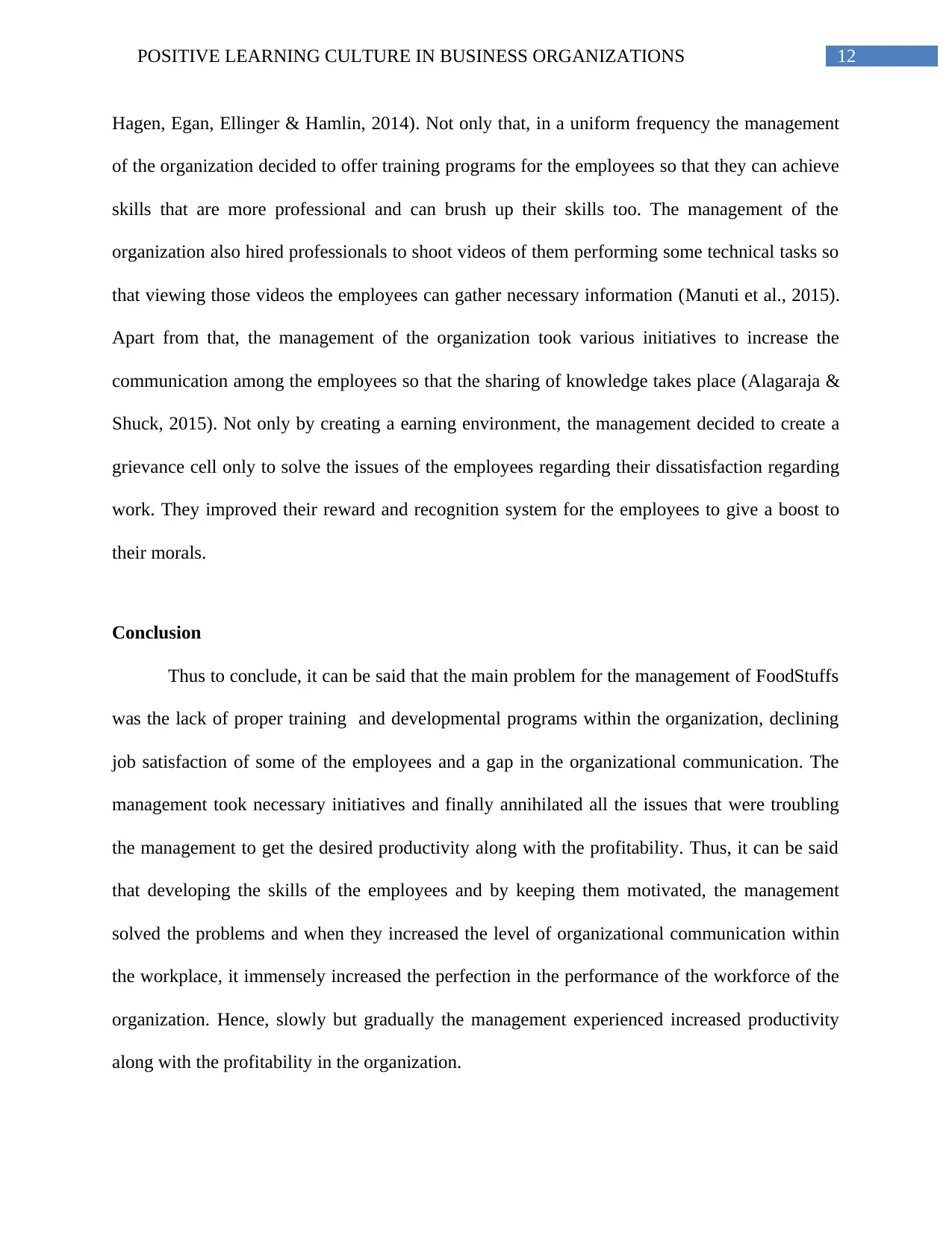
12POSITIVE LEARNING CULTURE IN BUSINESS ORGANIZATIONS
Hagen, Egan, Ellinger & Hamlin, 2014). Not only that, in a uniform frequency the management
of the organization decided to offer training programs for the employees so that they can achieve
skills that are more professional and can brush up their skills too. The management of the
organization also hired professionals to shoot videos of them performing some technical tasks so
that viewing those videos the employees can gather necessary information (Manuti et al., 2015).
Apart from that, the management of the organization took various initiatives to increase the
communication among the employees so that the sharing of knowledge takes place (Alagaraja &
Shuck, 2015). Not only by creating a earning environment, the management decided to create a
grievance cell only to solve the issues of the employees regarding their dissatisfaction regarding
work. They improved their reward and recognition system for the employees to give a boost to
their morals.
Conclusion
Thus to conclude, it can be said that the main problem for the management of FoodStuffs
was the lack of proper training and developmental programs within the organization, declining
job satisfaction of some of the employees and a gap in the organizational communication. The
management took necessary initiatives and finally annihilated all the issues that were troubling
the management to get the desired productivity along with the profitability. Thus, it can be said
that developing the skills of the employees and by keeping them motivated, the management
solved the problems and when they increased the level of organizational communication within
the workplace, it immensely increased the perfection in the performance of the workforce of the
organization. Hence, slowly but gradually the management experienced increased productivity
along with the profitability in the organization.
Hagen, Egan, Ellinger & Hamlin, 2014). Not only that, in a uniform frequency the management
of the organization decided to offer training programs for the employees so that they can achieve
skills that are more professional and can brush up their skills too. The management of the
organization also hired professionals to shoot videos of them performing some technical tasks so
that viewing those videos the employees can gather necessary information (Manuti et al., 2015).
Apart from that, the management of the organization took various initiatives to increase the
communication among the employees so that the sharing of knowledge takes place (Alagaraja &
Shuck, 2015). Not only by creating a earning environment, the management decided to create a
grievance cell only to solve the issues of the employees regarding their dissatisfaction regarding
work. They improved their reward and recognition system for the employees to give a boost to
their morals.
Conclusion
Thus to conclude, it can be said that the main problem for the management of FoodStuffs
was the lack of proper training and developmental programs within the organization, declining
job satisfaction of some of the employees and a gap in the organizational communication. The
management took necessary initiatives and finally annihilated all the issues that were troubling
the management to get the desired productivity along with the profitability. Thus, it can be said
that developing the skills of the employees and by keeping them motivated, the management
solved the problems and when they increased the level of organizational communication within
the workplace, it immensely increased the perfection in the performance of the workforce of the
organization. Hence, slowly but gradually the management experienced increased productivity
along with the profitability in the organization.
Paraphrase This Document
Need a fresh take? Get an instant paraphrase of this document with our AI Paraphraser
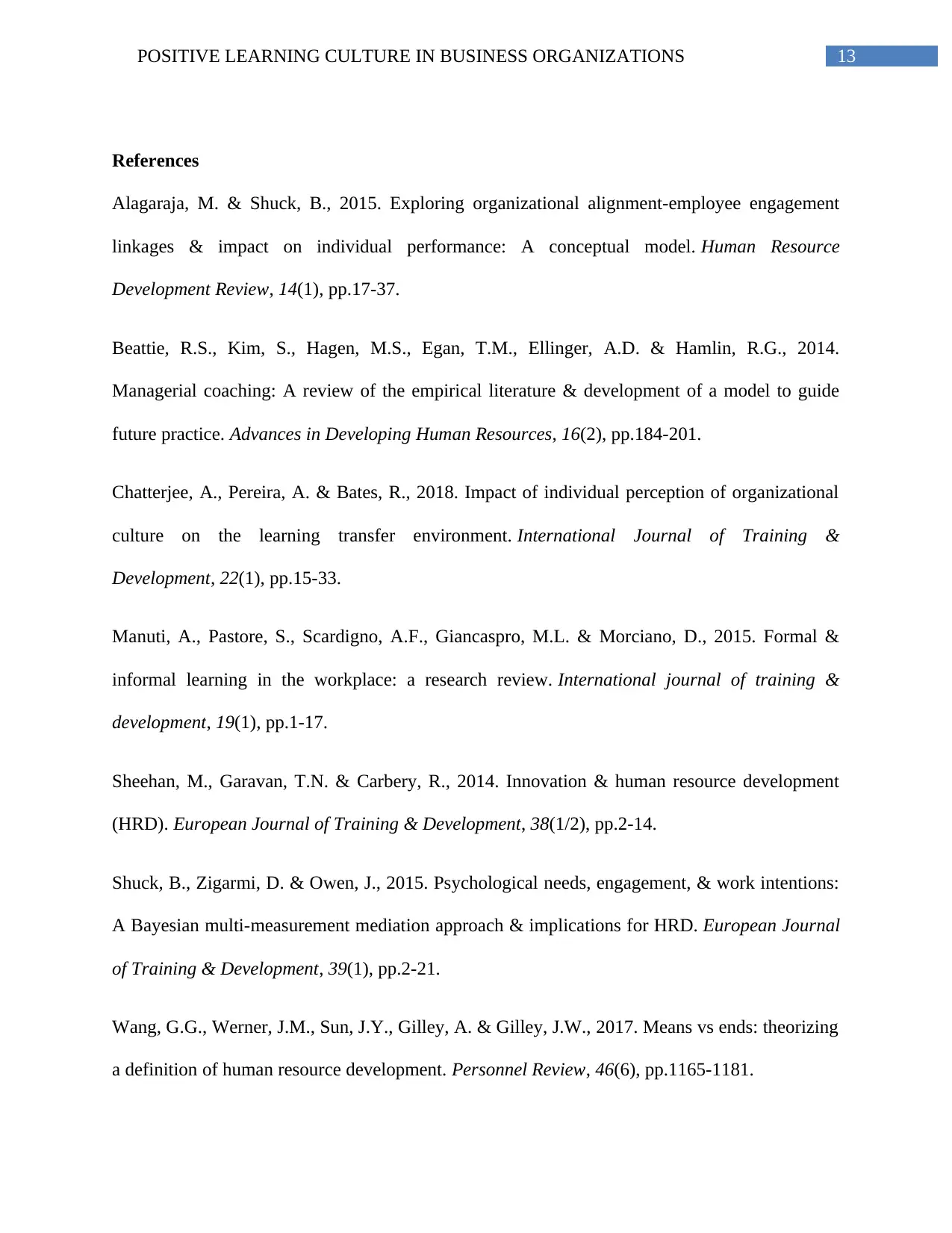
13POSITIVE LEARNING CULTURE IN BUSINESS ORGANIZATIONS
References
Alagaraja, M. & Shuck, B., 2015. Exploring organizational alignment-employee engagement
linkages & impact on individual performance: A conceptual model. Human Resource
Development Review, 14(1), pp.17-37.
Beattie, R.S., Kim, S., Hagen, M.S., Egan, T.M., Ellinger, A.D. & Hamlin, R.G., 2014.
Managerial coaching: A review of the empirical literature & development of a model to guide
future practice. Advances in Developing Human Resources, 16(2), pp.184-201.
Chatterjee, A., Pereira, A. & Bates, R., 2018. Impact of individual perception of organizational
culture on the learning transfer environment. International Journal of Training &
Development, 22(1), pp.15-33.
Manuti, A., Pastore, S., Scardigno, A.F., Giancaspro, M.L. & Morciano, D., 2015. Formal &
informal learning in the workplace: a research review. International journal of training &
development, 19(1), pp.1-17.
Sheehan, M., Garavan, T.N. & Carbery, R., 2014. Innovation & human resource development
(HRD). European Journal of Training & Development, 38(1/2), pp.2-14.
Shuck, B., Zigarmi, D. & Owen, J., 2015. Psychological needs, engagement, & work intentions:
A Bayesian multi-measurement mediation approach & implications for HRD. European Journal
of Training & Development, 39(1), pp.2-21.
Wang, G.G., Werner, J.M., Sun, J.Y., Gilley, A. & Gilley, J.W., 2017. Means vs ends: theorizing
a definition of human resource development. Personnel Review, 46(6), pp.1165-1181.
References
Alagaraja, M. & Shuck, B., 2015. Exploring organizational alignment-employee engagement
linkages & impact on individual performance: A conceptual model. Human Resource
Development Review, 14(1), pp.17-37.
Beattie, R.S., Kim, S., Hagen, M.S., Egan, T.M., Ellinger, A.D. & Hamlin, R.G., 2014.
Managerial coaching: A review of the empirical literature & development of a model to guide
future practice. Advances in Developing Human Resources, 16(2), pp.184-201.
Chatterjee, A., Pereira, A. & Bates, R., 2018. Impact of individual perception of organizational
culture on the learning transfer environment. International Journal of Training &
Development, 22(1), pp.15-33.
Manuti, A., Pastore, S., Scardigno, A.F., Giancaspro, M.L. & Morciano, D., 2015. Formal &
informal learning in the workplace: a research review. International journal of training &
development, 19(1), pp.1-17.
Sheehan, M., Garavan, T.N. & Carbery, R., 2014. Innovation & human resource development
(HRD). European Journal of Training & Development, 38(1/2), pp.2-14.
Shuck, B., Zigarmi, D. & Owen, J., 2015. Psychological needs, engagement, & work intentions:
A Bayesian multi-measurement mediation approach & implications for HRD. European Journal
of Training & Development, 39(1), pp.2-21.
Wang, G.G., Werner, J.M., Sun, J.Y., Gilley, A. & Gilley, J.W., 2017. Means vs ends: theorizing
a definition of human resource development. Personnel Review, 46(6), pp.1165-1181.
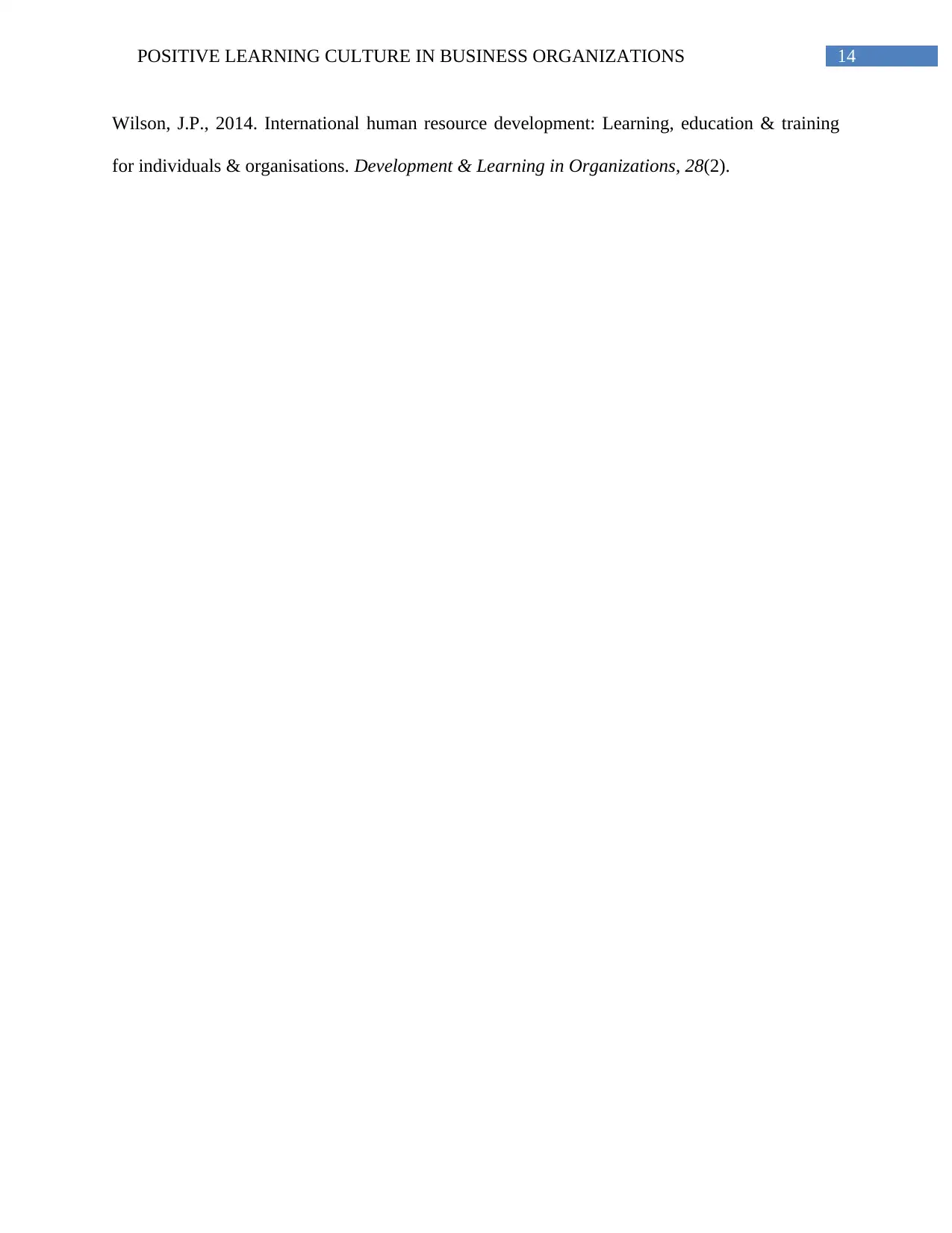
14POSITIVE LEARNING CULTURE IN BUSINESS ORGANIZATIONS
Wilson, J.P., 2014. International human resource development: Learning, education & training
for individuals & organisations. Development & Learning in Organizations, 28(2).
Wilson, J.P., 2014. International human resource development: Learning, education & training
for individuals & organisations. Development & Learning in Organizations, 28(2).
1 out of 15
Your All-in-One AI-Powered Toolkit for Academic Success.
+13062052269
info@desklib.com
Available 24*7 on WhatsApp / Email
![[object Object]](/_next/static/media/star-bottom.7253800d.svg)
Unlock your academic potential
© 2024 | Zucol Services PVT LTD | All rights reserved.





